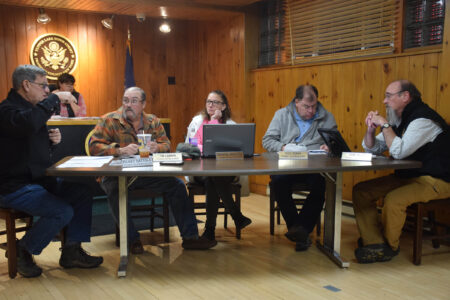‘Big Beautiful Bill’ endangers North Country health care
Trump and allies argue system is strengthened by cutting out ‘waste, fraud and abuse’
The spending bill that passed the House on Thursday contains large cuts to Medicaid, something that rural areas including the North Country are increasingly reliant on. While supporters of the bill argue the changes will strengthen Medicaid, the possible loss of revenue to local health systems could cause some services to become unavailable for everyone, according to several North Country doctors.
Rushing to pass the so-called “Big Beautiful Bill” ahead of President Donald Trump’s July 4 deadline, Republicans in the House passed the much-anticipated tax and spending legislation 218-214. Two Republicans, Brian Fitzpatrick of Pennsylvania and Thomas Massie of Kentucky, joined all of the Democrats in voting no. North Country Rep. Elise Stefanik voted yes.
Medicaid, which provides government-funded insurance for low-income, middle class and disabled people, is also a significant funding source for local hospitals, nursing homes, home care and more. Concerns around cuts to the program have mobilized the Healthcare Coalition of the North Country, an organization formed to help both citizens and elected officials understand the importance of Medicaid to the rural health systems.
John Rugge, chair of the coalition and founder of the Hudson Headwaters Health Network, said reforms to Medicaid — and to the health care system more broadly — are necessary. However, he said the approach of making huge cuts to Medicaid is not precise enough to solve the real problems.
“Reforms are always necessary with a system as big as healthcare,” he said. “But (we should) not to try to change the entire system by just picking on one part of it.”
The coalition estimates that about 215,000 people in NY-21, or 28% of the population, uses Medicaid in some way. In the North Country, 50% of all childbirths and 34.5% of the children are covered by Medicaid. More than 60% of nursing home residents in New York are covered by Medicaid.
Rural health care providers are also in a unique position because they tend to be in smaller communities where there is often only one provider. If there’s no way to pay for someone’s care, a rural physician has a harder job turning them away.
“My own experience tells me if somebody lives or just deeply practices in that kind of area, there’s no way when somebody comes to the door of the office to say, ‘No, I can’t see you,'” Rugge said.
–
Details of the bill
–
The nonpartisan Congressional Budget Office estimates that the bill will reduce federal spending on Medicaid by over $1 trillion over 10 years and will cause 11.8 million people nationwide to become uninsured. This reduced spending comes from a variety of provisions in the bill.
Rugge said he was most concerned about the impact of a few particular aspects of the bill, one of which was the addition of more strict work requirements. He said the belief that a bunch of people on Medicaid aren’t working isn’t true.
A Kaiser Family Foundation analysis of the March 2024 Current Population Survey found that 44% of adults on Medicaid were working full-time and 20% were working part-time. Those who were not working were, in large part, not working due to caregiving (12%), illness or disability (10%) or school attendance (7%). The remaining 8% who were not working include people not working due to retirement or inability to find work.
The added work requirements, in addition to other changes that will add paperwork and bureaucracy for people to get Medicaid benefits, is likely to force many off the program, even those who are eligible.
The bill also changes provisions for state participation in multiple ways. For example, it limits provider taxes — a tax on health care providers that help states afford Medicaid programs and funnel money back to providers with the help of matching federal dollars.
The Senate-passed version of the bill addresses some lawmakers’ concerns about the impact of Medicaid cuts on rural hospitals by increasing the rural health fund from $25 billion to $50 billion. However, analysis by KFF estimates that the bill will decrease federal Medicaid spending in rural areas by $155 billion.
–
Local costs
–
In every state except New York, the cost of Medicaid is shared between the state and the federal government. New York is the only state where local governments pay a small portion of the state’s share. According to the state Comptroller, Medicaid spending in New York was $101.5 billion in the 2024 fiscal year, of which the federal government paid $57.1 billion (56.2%), the state paid $35.9 billion (35.4%) and localities paid $8.5 billion (8.4%).
The national policy center, Center for Healthcare Quality and Payment Reform, has studied the crisis of rural hospitals. In New York, six rural hospitals have closed since 2005 and there are currently 51 remaining rural inpatient hospitals. Of those hospitals, 63% percent lose money from providing patient services because it costs more to deliver care in rural areas and because many insurance plans do not pay enough for those services. The center estimates that more than half of rural hospitals in New York are at risk of closing.
One service that tends to get cut when hospitals are struggling is maternal care. A little less than half of rural hospitals in New York have labor and delivery units, according to the CHQPR. Of the labor and delivery units that remain, 33% are at risk of closing.
According to data from the CHQPR, Adirondack Medical Center in Saranac Lake has an average two-year patient services margin of -5.1%, which takes into account the two most recent years with available data. The same data sources shows that about 12.2% of patient services costs at AMC are paid by Medicaid, the Children’s Health Insurance Program and state or local indigent care programs.
Aaron Kramer, CEO of Adirondack Health, signaled both optimism and concern in his remarks during Sen. Gillibrand’s press conference at AMC on June 16. In describing the hospital’s finances, he said many aspects of health care finances are inherently unpredictable, so their focus is on sustainability.
“Adirondack Health has been a part of Saranac Lake and the surrounding communities, in some form, for more than 100 years — and it’s our intent to be here for at least 100 more,” Kramer said.
He said the hospital is able to pay employees and keep the lights on, but they don’t have the cash to make consistent capital investments. He said 15% of the hospital’s patients get insurance from Medicaid programs, and in the maternity unit, 30% are funded by Medicaid.
“We do know that we operate on incredibly tight margins,” Kramer said. “So any cuts to reimbursement or increases in uncompensated care are harmful and endanger the financial sustainability of this region’s sole community hospital and largest private employer.”
Adirondack Health is the largest private employer in the Adirondack Park and has a $200 million annual economic impact, according to Kramer.
According to the Healthcare Coalition of the North Country, 16.4% of the North Country’s population is employed by the healthcare sector. Statewide, the Commonwealth Fund estimated that the cuts to Medicaid and SNAP could result in at least 114,200 jobs, or 1.1%, being lost.
–
Trump and allies argue promises are kept
–
A Stefanik spokesman responded via email to Enterprise questions about health care coverage concerns.
“Republicans want to strengthen and secure Medicaid for eligible citizens as it is an indispensable lifeline for our nation’s most vulnerable,” he wrote. “However, Far Left Democrats continue to fearmonger because they know that President Trump is delivering results for the American people.”
To justify the cuts, the Stefanik spokesman referred two examples of “wasteful and fraudulent government spending.” The first example was from a New York Post article claiming that $20 billion is spent on fraudulent Medicaid claims annually. This article cited a 2024 report from the nonpartisan think tank Empire Center, which analyzed census data that found 3 million New Yorker enrollees “appear to have incomes above the eligibility limits for either Medicaid or the Essential Plan.”
The second example cited data about “illegals” who are eligible for emergency Medicaid. This data was also from the Empire Center, which said emergency Medicaid enrollment had increased 1,200% and spending on it had tripled since 2014 in New York. About three quarters of recipients lived in New York City, according to the same analysis.
“This spending is unsustainable and in order to continue protecting and preserving benefits for America’s most vulnerable, waste, fraud and abuse must be rooted out,” Stefanik’s spokesman said.
Stefanik and other like-minded Republicans are promoting the bill as a tax cut that will help everyday Americans.
“Promises made, promises kept,” Stefanik posted on Facebook directly after the bill passed. “I was proud to stay in Congress to vote to pass the One Big Beautiful Bill to deliver on President Trump’s historic mandate to enact the largest tax cut in American history, turbocharge economic growth, secure our borders, restore energy dominance, cut wasteful spending and deliver peace through strength.”
The tax policy will reduce taxes for most Americans, excluding those who make too little to pay federal income tax in the first place. The left-leaning Tax Policy Center estimates that the bill will reduce taxes by about 1.9% for the middle quintile. Most recently, Biden’s 2021 coronavirus stimulus package cut taxes by 6% for the middle quintile, according to TPC analysis.
Although the tax cuts are significant, the nonpartisan Congressional Budget Office estimated that the bill overall would decrease household resources — a measure that includes income, benefits and other nonmonetary resources — by 2% for the bottom 10% of earners. The top 10% of earners would see their household resources increase by 4%. The CBO also estimated the bill will add $3.3 trillion to the national debt over a decade.



